Hello all!
Well it’s been a learned couple of months for me; one seems to be cramming as much taxonomy skills into my little head as possible! I worry there must be a capacity limit to these things and where new knowledge is gained, unused information may get replaced, and it’s only going to get worse!! Actually it’s all been really good and valuable and if I forget how to tie my shoe laces someday I’ll know it’s all been for the greater good of the environment! Ha.
I’m referring to the Diatom course that I went on in London, it was absolutely brilliant! A really popular course with academics travelling from Canada, New Zealand and …Shetland! Lol! I thought I was far far away. It was really cool to meet my peers and the people I’d been reading about such as Helen Bennion. The course itself was incredibly interesting and I really liked feeling like a student again for the week. It was great chatting to the other Diatomists, hearing what they were researching for their PhD or Masters. The lectures about diatoms were especially good, we learned about morphology, habitats, sampling techniques, the effects of eutrophication, climate change, and acidification and also the methods in identification and counting, which were the most beneficial to me. I think the course has given me such a head start with the diatom identification; that I would not have been able to pick up as quickly on my own having not been on the course. It’s not an easy thing, but I got a bit of encouragement from one of the PhD students here in Glasgow who said it took him two weeks to count his first slide which was a relief as it’d taken me three days to do one!!
So far I’ve counted 26 species at one of my Glengonnar sites. The site I’ve looked at is the furthest downstream of the abandoned mine, yet there are still quite a number of distorted or “twisted” valves which are characteristic of water courses contaminated with metal pollution. It’s evident from looking at my control sites on the Elvan that there are definitely no signs of distorted valves… which I’m glad to see as we’re assuming they’re metal free! Yet it’s fascinating to think what sort of effect the metal is having on the algae and how it is causing these deformations, the more I look at them the more questions I’m asking.
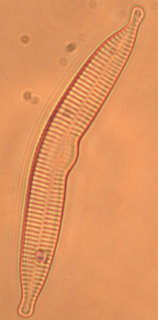
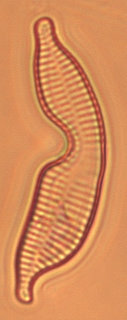
The picture shows a normal Hannaea arcus and a distorted valve of the same species. I’ve also included some pictures of some of the other interesting finds including two Ecyonema silesiacum, which are half-moon shaped and are tolerant to high nutrient levels.
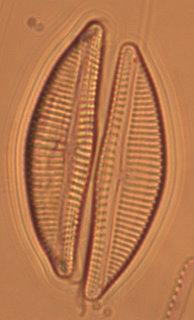
Luckily I’ve just been given a bursary from BRISC and the Glasgow Natural History Society to contribute towards the cost of a Field Studies Council Algae Course in Kindrogan. So hopefully by the end of my apprenticeship I’ll be an algae expert and have all my phycological questions answered! They’ve asked that I write an article of my experiences on the course which will be published in their newsletter. Fab!
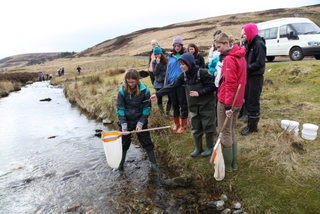 Amongst all this looking down a microscope at little tiny things, I’ve been putting together information sheets for the BTCV Biodiversity training workshops in June, which tested my taxonomic skills and was good revision for me. Also the Clyde River Foundation led a class for the Zoology and Freshwater Biology Honours students. We took them up to the Elvan and Glengonnar to demonstrate the biological recording we do and the fisheries science. It was so nice to be outside and in a headwater again! The lab session was good the next day, but tiring! I did enjoy the teaching side of it though.
Amongst all this looking down a microscope at little tiny things, I’ve been putting together information sheets for the BTCV Biodiversity training workshops in June, which tested my taxonomic skills and was good revision for me. Also the Clyde River Foundation led a class for the Zoology and Freshwater Biology Honours students. We took them up to the Elvan and Glengonnar to demonstrate the biological recording we do and the fisheries science. It was so nice to be outside and in a headwater again! The lab session was good the next day, but tiring! I did enjoy the teaching side of it though.
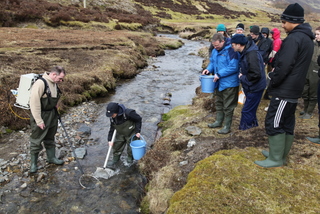
Next week I’m looking forward to going to the Scottish Freshwater Group Meeting, I missed the last one as it clashed with my sampling but thankfully this one is even more relevant to me as there are two talks on headwaters. SPOILED!
*MEANWHILE* – I can hardly believe I’ve been a Natural Talent apprentice for nearly a whole year and there are only four month’s left – SCARY! But they are going to be busy busy months, with writing up my project which to be honest I’m not looking forward to doing but I will look forward to the final product! It will feel like such an achievement to have something to put my name to. Other fun things will be all the many aquatic workshops that we’ll be running, and I’ll be involved in this years “Meet your River” ran by the Clyde River Foundation.
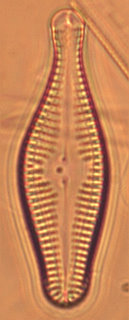
<— Say hello to Mr. Skittle-face: a Gomphonema spp. which I haven’t worked out the species yet, but he looks like a bowling-pin I thought!!
Bye for now!
Lesley Gregg – Headwater’s Apprentice
